

(C) UAE
The UAE has planned to spend $23 billion on clean technology within the next five years. This massive strategy is expected to lead the UAE to become a major power in the world’s clean energy hub. ADNOC will lead this effort to produce 5% of the global demand for hydrogen that is free from carbon by the year 2030.
Hydrogen and ammonia are other important industrial chemicals, with hydrogen used especially in the processing of metals and ammonia in the manufacture of chemicals and fertilizers.
ADNOC aims to produce hydrogen and ammonia in the UAE and the US Texas. The company will focus on two types of hydrogen: Blue hydrogen obtained from fossil fuels with low levels of CO2 emissions, and green hydrogen which is generated using renewable energy. Both of them will be converted into ammonia for transportation convenience and then be exported to Asia and European countries like Japan and South Korea.
The relations between ADNOC and Japanese companies go back to the 1960s. Musabbeh Al Kaabi, ADNOC’s executive director of low-carbon opportunities, said he is proud of this partnership and stressed that the company is determined to help Japanese and other customers in their quest to drastically cut their carbon emissions. The Japanese government intends to encourage the use of ammonia, and this will be in line with the export strategy of ADNOC.
Alongside clean hydrogen production, the UAE also has clear goals set for CCS, that are considered to be rather lofty. The country plans to sequester up to 10 million tonnes of carbon dioxide annually by 2030, the same as the amount emitted by some 2.4 million passenger vehicles. ADNOC already has operating facilities of 800000 tonnes per year and has further plans for commercialization for projects of 3 million tonnes per year.
To sustain its position on the global map of energy providers the UAE is following a dual-track plan. On the one hand, it is simultaneously striving to expand oil and natural gas but, on the other hand, the government is also investing more in the development of low-carbon energy technologies. To decrease the intensity of GHG emissions from oil production, ADNOC intends to spend approximately $4 billion on undersea power cables. These cables will be used to carry power from wind farms and solar power stations, as well as other nuclear and conventional power stations to offshore oil platforms.
While developed countries have set the target for net-zero emissions by 2050, emerging countries are witnessing a steep rise in energy consumption. This could mean that fossil fuels are stuck as the future energy source beyond 2050. The UAE’s investment in clean energy technologies cautions that it is possible to pursue both energy generation and the successful stewardship of the natural world. Using hydrogen and ammonia technology, the UAE seeks to continue as a vital player in the global energy market while achieving net-zero carbon emission status.
The 78th Palme d’Or aka Cannes Film Festival will be taking place from 13 - 24 May 2025 at Palais…
OTT platforms are becoming inevitable in our routine life, because we need an off or a break which is well-spent…
With the aim of promoting one of the highly watched sports in the world which is cricket, in the East-Asia…
First time, a strategic five year initiative has been agreed between Imagica Group who are from Japan and Cannes, in…
Every household in Singapore can from 13th May 2025 receive $500 worth of Community Development Council (CDC) vouchers under the…
The love towards Asian dramas is expanding everyday and audiences are curious in exploring the diverse contents in various languages…
This website uses cookies.
Read More